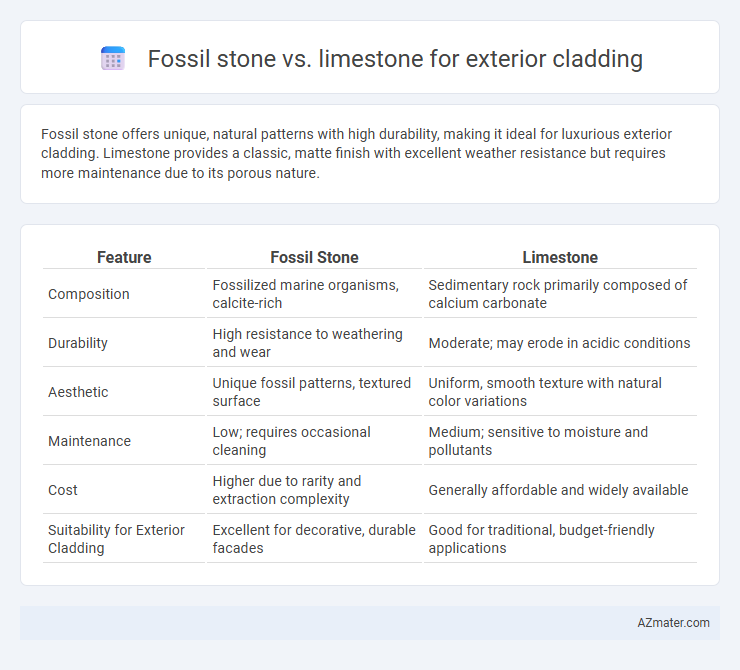Fossil stone offers unique, natural patterns with high durability, making it ideal for luxurious exterior cladding. Limestone provides a classic, matte finish with excellent weather resistance but requires more maintenance due to its porous nature.
Table of Comparison
| Feature | Fossil Stone | Limestone |
|---|---|---|
| Composition | Fossilized marine organisms, calcite-rich | Sedimentary rock primarily composed of calcium carbonate |
| Durability | High resistance to weathering and wear | Moderate; may erode in acidic conditions |
| Aesthetic | Unique fossil patterns, textured surface | Uniform, smooth texture with natural color variations |
| Maintenance | Low; requires occasional cleaning | Medium; sensitive to moisture and pollutants |
| Cost | Higher due to rarity and extraction complexity | Generally affordable and widely available |
| Suitability for Exterior Cladding | Excellent for decorative, durable facades | Good for traditional, budget-friendly applications |
Introduction to Exterior Cladding Materials
Fossil stone and limestone are popular choices for exterior cladding due to their natural durability and aesthetic appeal. Fossil stone, composed of preserved marine fossils within a sedimentary matrix, offers unique textures and patterns that enhance architectural facades. Limestone provides a versatile, weather-resistant surface with a classic look, widely favored for both modern and traditional building exteriors.
What is Fossil Stone?
Fossil stone is a natural sedimentary rock composed of preserved remains of ancient marine organisms, often rich in visible fossil imprints that create unique patterns and textures ideal for exterior cladding. Compared to limestone, fossil stone offers greater aesthetic appeal due to its distinct fossil inclusions and higher density, which enhances durability and weather resistance. Its natural thermal insulation properties and ability to age gracefully make fossil stone a preferred choice for sustainable and visually striking exterior facades.
What is Limestone?
Limestone, a sedimentary rock primarily composed of calcium carbonate, is widely used in exterior cladding due to its durability and natural beauty. Fossil stone differs as it often contains visible fossils, adding unique texture and historical appeal, whereas limestone offers a more uniform and versatile appearance suitable for various architectural styles. Both materials provide excellent weather resistance, but limestone's ease of carving and maintenance make it a preferred choice for detailed facade work.
Key Differences Between Fossil Stone and Limestone
Fossil stone features visible remains of prehistoric organisms embedded within its structure, offering a unique, textured appearance, while limestone is a sedimentary rock primarily composed of calcium carbonate with a more uniform and smooth surface. Fossil stone tends to be more durable and resistant to weathering due to its dense fossil inclusions, making it suitable for long-lasting exterior cladding applications, whereas limestone requires more maintenance to prevent erosion and discoloration. The cost of fossil stone is generally higher due to its rarity and decorative appeal, whereas limestone is widely available and budget-friendly for large-scale exterior projects.
Appearance and Aesthetic Qualities
Fossil stone features unique embedded fossils that create intricate, natural patterns, offering a distinctive and elegant appearance for exterior cladding. Limestone typically presents a smoother, more uniform texture with soft, neutral tones that complement a wide range of architectural styles. The fossil stone's detailed visuals provide a striking focal point, while limestone's classic look delivers timeless sophistication.
Durability and Weather Resistance
Fossil stone offers superior durability for exterior cladding due to its dense, compact composition, which resists weathering and erosion more effectively than limestone. Limestone, while aesthetically appealing, is more porous and susceptible to water absorption, leading to potential damage from freeze-thaw cycles and acid rain exposure. Choosing fossil stone enhances long-term weather resistance, reducing maintenance needs and preserving facade integrity in harsh climates.
Maintenance Requirements
Fossil stone exterior cladding requires minimal maintenance due to its dense composition, offering superior resistance to weathering and staining compared to limestone. Limestone is more porous and susceptible to erosion, staining, and moss or algae growth, necessitating regular sealing and cleaning to preserve its appearance and structural integrity. Both materials benefit from periodic inspections, but fossil stone's durability reduces long-term upkeep costs significantly.
Environmental Impact and Sustainability
Fossil stone, containing preserved ancient marine life, offers a unique aesthetic with a relatively low carbon footprint due to minimal processing, making it environmentally favorable for exterior cladding. Limestone, while abundant and durable, often requires more intensive quarrying and processing, leading to higher emissions and habitat disruption. Choosing fossil stone supports sustainability by leveraging natural historical formations with reduced environmental damage compared to conventional limestone extraction methods.
Cost Comparison: Fossil Stone vs Limestone
Fossil stone generally commands a higher price than limestone due to its unique fossil patterns and limited availability, making it a premium choice for exterior cladding. Limestone offers a more cost-effective solution, with lower material and installation expenses while still providing durability and aesthetic appeal. Budget-conscious projects often prefer limestone for its affordability, whereas fossil stone suits high-end applications where visual impact justifies the premium.
Which Stone is Best for Your Exterior Cladding?
Fossil stone offers a unique, textured appearance with embedded ancient marine life patterns, providing durability and weather resistance ideal for exterior cladding. Limestone, valued for its smooth surface and natural light color palette, is breathable yet softer, requiring more maintenance in harsh climates. Choosing between fossil stone and limestone depends on the desired aesthetic, climate resilience, and long-term maintenance considerations for your building's exterior.

Infographic: Fossil stone vs Limestone for Exterior Cladding
 azmater.com
azmater.com